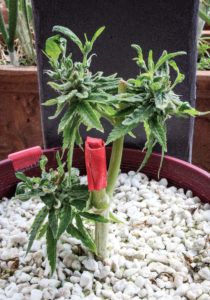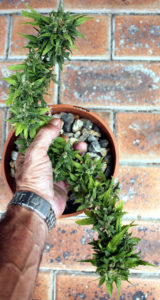Here’s a systematic approach to cost-effective cultivation using the regeneration technique to harvest several times from the same garden.
Proceed with the harvest as follows: Ensure that your scissors or garden cutters are capable of slicing through the trunk with one stroke free of jagged edges.
Sterilize the cutters. Unlike a traditional harvest, regeneration requires a clean and healthy cut. A solution of 10% bleach (or hydrogen peroxide) in water is ideal for sterilization. Soak your cutters for a few minutes, then rinse. Alternately, wipe the blades using a rag dampened with methylated spirits. Vodka or any spirit may be substituted. A cheap aftershave (it’s the alcoholic content that makes your face zing) or a disinfectant hand wipe will also do the trick. Be sure to dry the cutters completely before use.
Locate a spot an inch or so above the lowest first or second buds on the main trunk—very low on the trunk, allowing for a complete and traditional harvest of the whole plant above. The regular house key, jammed into the growing medium in the photograph above, indicates scale—demonstrating how little bud matter needs to be retained for regeneration.
Holding your cutters horizontally, cut the trunk at the position indicated. Do not cut on an angle, as you do with cloning (to increase the surface area), but straight across. You want the area exposed by the cut to be as small as possible: A circular cross-section has a smaller surface area than an oval one.
Hang the top 99% of the plant upside down to begin the drying process.
Immediately return to the potted trunk and begin the rescue/stabilization routine described below. Time is of the essence here. Don’t become distracted by the harvested material, such as removing the fan leaves and other tidying up; these things can wait until later.
So far, so good: You’re already a step ahead of where you’d normally find yourself. This makes you a forward-thinking person. It also makes you someone with a full, lush, no-compromise harvest and the potential to regenerate a repeat performance. You are ready to start the real process: bringing your plant back to life.

A pair of buds about to receive a minor haircut.
Rescuing and Regenerating Your Harvested Plant
Within 10 minutes of making the chop, you’ll want to cap the wound and then promptly address other issues like nutrients and the light cycle. The aim is to immediately reduce the plant’s stress. To put things into perspective, imagine if your body had been completely severed at the ankles: You’d be stressed—seriously stressed. Now consider how your feet would feel about it! Here are the three steps you must follow:
Step One: Capping the Donor Plant
Consider the duct tape a medicinal plaster. You need to seal off the stump’s open wound—partly in an effort to stabilize the plant’s plumbing, which is well and truly shot, but also to protect the exposed innards from air, light, dirt, insects and bacteria. Fortunately, the target buds that we’ll be working with are below the cut point and thus are serviced by the plant’s vascular system before the damage is encountered. However, we don’t want air to enter the wound, creating a usually fatal embolism (air pocket). Seal off the wound immediately with duct tape as follows:
Eyeball the cut on the trunk, estimating the wound’s diameter. Let’s assume it’s half an inch.
Tear off a square piece of duct tape twice the estimated diameter (so, in this example, a 1-inch square piece of tape).
Center the tape, adhesive side down, across the wound. With your thumb and fingers, secure the tape, pressing it firmly down around the edges.
Tear off a second piece of tape, the same width as the first but long enough to encircle the trunk. Wrap it around the trunk, securing the first piece in position. Be thorough—make the tape as airtight as possible. Squeeze it tight.
Now that your plant is capped, the urgency is decreased. She’ll be a little thirsty, so now we need to feed her some water and prepare her with a mild bed of nutrients.

The tape encircling the trunk creates an airtight cap.
Step Two: Nutrients
Not only is it traditional practice to allow the growing medium to dry a little bit before harvest, but good technique also demands that the plant be flushed for a couple of weeks prior. This flushing—pouring a large quantity of water through the pot—is designed to rinse out the remaining nutrients that would otherwise taint the final product. Several flushes across the final two weeks of flowering normally do the trick, providing a nice, clean product. However, it does rinse the goodness out of the growing medium. If we’re to regenerate our plant, she’ll be requiring nutrients at some point. We need to make sure these are available when she’s ready.
Fill a small watering can with tepid (lukewarm) water. Remember, we’re trying to reduce stress as much as possible. The shock of cold water is not welcome at this point.
Balance the pH to your norm. (The ideal balance, best suited to the particular strain you’re growing, will have been established during the first grow, prior to the initial harvest. Both strain and medium dictate the pH requirements. You’ll be between 5.8 and 6.8 as a rule. I grow in 100% perlite and hold the pH at 6.0. I believe this to be very important for the delicate beginnings of regeneration.
Mix in a mild (25%) solution of your regular vegetative nutrient. This should contain nitrogen and the other nutes that your plant will need when she begins to sprout new shoots. Be careful: Many fertilizers are “hot” and should be considered full strength at 50%. So take it easy. You want a mild solution, one similar to what you’d use when transplanting, repotting or at other stressful moments in a plant’s life. The plant requires a firm but gentle dose of nitrogen and the availability of other essentials like phosphorus, potassium, calcium, sulfur, iron and magnesium. I use a 25% solution of either Canna Vega, which is a Dutch grow formula, or PowerFeed for Vegies: This is an organic-based fertilizer containing a nice spectrum of base elements, amino acids and a high level of nitrogen. I combine this with a 25% dilution of a product called Seasol. Made by the same company, this is a seaweed extract containing no nitrogen but an abundance of other trace goodies. You want to make sure that your plant has all the nutrients she needs to recover strongly, but you don’t want to overwhelm her. As with any grow, you’ll increase the strength of your nutrients after your plant has found her feet and entered a phase of abundant growth.
Check the pH, making sure it’s still stable. If not, adjust accordingly. We cannot afford pH problems at this point.
Water the capped plant heavily so that the roots are saturated and run-off is observed at the bottom of the pot.
Set the watered pot on a little wedge or gentle slope, enabling the excess water to run free. (A small pebble will do the trick.) Allow 20 minutes for this. You don’t want the pot to remain saturated; cannabis does not like wet feet.
We can expect two different types of regrowth, which I call “elongation” and “flurry”—and I prefer tipping the scales toward flurry. To do this, we’ll give the buds a little haircut. Using a sharp and sterilized pair of scissors, trim one-third off the top of each of the soon-to-be-regenerating buds. This mild surgery has the effect of taking out the growing tip and discouraging elongation. And much like when you tip a terminal shoot on a vegetating plant, the plant’s energy is redirected to the growing areas immediately below. In our case, energy is shifted to the surrounding calyxes. It’s the transformation of these calyxes back into growing tips that creates the flurry we desire.
At this point, your plant is about as comfortable as she’s going to get. To encourage regrowth, we simply need to adjust the lighting regimen, forcing immediate and rigorous photosynthesis.

A novelty “double-ended bud” that can be grown using the system.
Step Three: Lighting Requirements
The regeneration process is kick-started by placing the plant back into a vegetative lighting schedule. You will have previously flowered the donor plant with a 12/12 light regime (i.e., 12 hours on and 12 hours off). Regeneration will require a 24/0 schedule. I’m usually not a fan of continuous illumination, as I believe a plant needs its night cycle. However, to kick-start the plant into regenerative mode, you must not allow her to “sleep”—not for a moment. So, 24-hour illumination it is (though I’ll change to 20/4 after the new growth has become apparent).
Another important consideration is light intensity. Your plant has everything it needs to move on: an established root system, nutrients, water and, now, light. Unlike cloning—which requires a gentle light to moderate photosynthesis, allowing for initial root development—our aim is to force photosynthesis immediately. Thus, the intensity of the light source is important. Being careful not to burn the plant, lower your light for maximum brightness and lumen saturation. Because the plant already has an established root system, she’s ready to get down and dirty.
While the lighting requirements for kick-starting regeneration are the opposite of what’s desired for cloning, the necessity for peace and rest is similar. It’s important now to leave the plant alone, allowing her to recover without disturbance. The leaves are like solar panels, and an about-to-be-regenerated plant cannot spare energy needlessly reconfiguring them to face the light if moved.
My golden rule here is to walk away for three days. Then, after this time, I’ll check to see if she needs a watering. If so, I’ll give her tepid, pH-adjusted water. In another two to four days, you should see signs of regrowth—revealing itself as new leaf formation at the crown of the buds, or as a couple of calyxes being pushed upward on tiny stalks.
Once you see these signs, you will know that regeneration has been successful. If you see no signs of new growth after a week or 10 days, be patient; give her another week. Strains with high vigor are always the best to regenerate, with F1 hybrids (the immediate offspring of parents of two different strains) being astounding in this respect. However, some plants may take two solid weeks to show signs of regrowth.
A plant that hasn’t revealed any signs of new life after three weeks should be discarded. Such a plant does not possess the vigor we desire for energetic regeneration. But there are no such problems with our rescued lady: The flurrying buds, two weeks out, are the signs of a successfully regenerated plant.
Adapted from Cannabis Regeneration: A Multiple Harvest Method for Greater Yields, by JB Haze, published by Green Candy Press, $16.
from
http://hightimes.com/grow/grow-hack-how-to-harvest-for-regeneration/
No comments:
Post a Comment